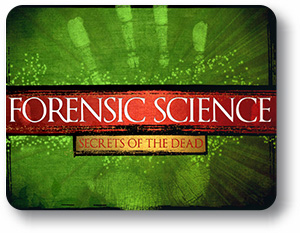
Forensic Science I Secrets of the Dead
Fingerprints. Blood spatter. DNA analysis. The world of law enforcement is increasingly making use of the techniques and knowledge from the sciences to better understand the crimes that are committed and to catch those individuals responsible for the crimes. Forensic science applies scientific knowledge to the criminal justice system. This course focuses on some of the techniques and practices used by forensic scientists during a crime scene investigation (CSI). Starting with how clues and data are recorded and preserved, the student will follow evidence trails until the CSI goes to trial, examining how various elements of the crime scene are analyzed and processed.
Unit 1: Introduction to Forensic Science
Blood, fingerprints, tire tracks, and trace evidence are used to catch the criminals in TV, but how do real life forensic scientists help identify suspects? In this unit, you will be introduced to forensic science. We will discuss what forensic science consists of and how the field developed through history. You will learn about some of the responsibilities of forensic scientists and about some of the specialty areas that forensic scientists may work in.
What will you learn in this unit?
Unit 2: The Crime Scene
Once a crime has been committed, one of the first steps for the forensic scientist is the identification and collection of evidence. In this unit, you will discover some of the techniques and practices that forensic scientists and law enforcement officials use to identify evidence and collect that evidence in a way that maintains the integrity of the evidence. You will also learn about some of the different types of evidence that might be found at a crime scene and how the different types of evidence may best be handled.
What will you learn in this unit?
Unit 3: Physical Evidence
In this unit, we will discuss the physical evidence found at crime scenes. In doing so, we will examine the different types of evidence that are used in a crime investigation and in court trials. We will also discuss how forensic scientists and investigators identify and collect evidence. Finally, we will look at some specific examples of physical evidence, including glass, soil, and impressions, to see how forensic scientists identify and analyze these types of evidence.
What will you learn in this unit?
Unit 4: Physical Evidence: Hair, Blood, and Fingerprints
In this unit, we will examine three potentially important types of physical evidence: hair, blood, and fingerprints. For each of these types of evidence, we will look at how the evidence may be collected and how the evidence might be tested. We will also discuss some of the challenges in examining these types of evidence and what we might learn from them.
What will you learn in this unit?
Unit 5: Firearms and Tool Marks
In this unit, we will discuss the collection and analysis of firearm and tool evidence. We will learn some of the considerations in collecting this type of evidence. We will also examine what information forensic scientists can learn from evidence like firearms, bullets, gunpowder residue, and tool marks that are left at a crime scene. Finally, we will discuss under what conditions individual characteristics might be found on these types of evidence.
What will you learn in this unit?
Unit 6: Human Remains
In this unit, you will learn more about how forensic scientists examine human remains and gain information from these remains. We will discuss some of the ways that forensic scientists try to determine the time of death for recovered human remains. We will also discuss how forensic scientists make use of the forensic autopsy to gain more information about a probable cause of death and mechanism of death. Finally, we will discuss what scientists can learn about the condition of bones found at a crime scene and some of the ongoing research by forensic scientists to learn more about rates of decomposition.
What will you learn in this unit?
Unit 7: DNA Evidence
In this unit, we will discuss what DNA is and how it is used as evidence in crime investigations. We will examine the basic components of DNA and learn what makes the DNA of each person unique. The unit will also discuss how biological evidence, like blood or hair samples, is preserved for DNA testing. Finally, we will examine the use of DNA evidence in court cases and some of the considerations that occur in these cases.
What will you learn in this unit?
Unit 8: Arson and Explosion Evidence
In this unit, we will discuss how forensic science approaches crime scenes in which fire or explosions have occurred. In doing so, we will learn about the challenges that these crime scenes present in the collection of evidence, the methods used to determine the point of ignition, and how evidence is collected and preserved at arson scenes. We will also examine some of the different types of explosives and how explosive materials are collected and preserved.
What will you learn in this unit?
